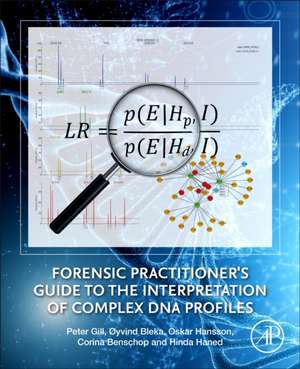Forensic Practitioner's Guide to the Interpretation of Complex DNA Profiles
Autor Peter Gill, Øyvind Bleka, Oskar Hansson, Corina Benschop, Hinda Haneden Limba Engleză Paperback – 10 iun 2020
Forensic Practitioner’s Guide to the Interpretation of Complex DNA Profiles places the main concepts of DNA profiling into context and fills a niche that is unoccupied in current literature. The book begins with an introduction to basic forensic genetics, covering a brief historical description of the development and harmonization of STR markers and national DNA databases. The laws of statistics are described, along with the likelihood ratio based on Hardy-Weinberg equilibrium and alternative models considering sub-structuring and relatedness. The historical development of low template mixture analysis, theory and practice, is also described, so the reader has a full understanding of rationale and progression. Evaluation of evidence and statement writing is described in detail, along with common pitfalls and their avoidance.
The authors have been at the forefront of the revolution, having made substantial contributions to theory and practice over the past two decades. All methods described are open-source and freely available, supported by sets of test-data and links to web-sites with further information. This book is written primarily for the biologist with little or no statistical training. However, sufficient information will also be provided for the experienced statistician. Consequently, the book appeals to a diverse audience
- Covers short tandem repeat (STR) analysis, including database searching and massive parallel sequencing (both STRs and SNPs)
- Encourages dissemination and understanding of probabilistic genotyping by including practical examples of varying complexity
- Written by authors intimately involved with software development, training at international workshops and reporting cases worldwide using the methods described in this book
Preț: 581.66 lei
Preț vechi: 754.78 lei
-23% Nou
Puncte Express: 872
Preț estimativ în valută:
111.30€ • 121.28$ • 93.79£
111.30€ • 121.28$ • 93.79£
Carte tipărită la comandă
Livrare economică 16-30 aprilie
Preluare comenzi: 021 569.72.76
Specificații
ISBN-13: 9780128205624
ISBN-10: 0128205628
Pagini: 530
Ilustrații: 150 illustrations (50 in full color)
Dimensiuni: 191 x 235 x 33 mm
Editura: ELSEVIER SCIENCE
ISBN-10: 0128205628
Pagini: 530
Ilustrații: 150 illustrations (50 in full color)
Dimensiuni: 191 x 235 x 33 mm
Editura: ELSEVIER SCIENCE
Public țintă
The book is primarily aimed at the practitioner: scientists who are dealing with case-work on a routine basis, and usually have not had formal statistical training. Because the book will assume little prior knowledge it will also be useful for University courses in forensic science. Specialist lawyers will find the book useful. It provides advice for court-reporting, including limitations of methods. Advanced users e.g. statisticians with little knowledge of forensics or the biological aspects will find the book useful. Mixture analysis is of interest in the medical genetics field and wildlife genetics.Cuprins
1. Forensic genetics: the basics2. Empirical characterization of DNA profiles3. Allele drop-out and the stochastic threshold4. Low-template DNA5. LRmix model theory6. A qualitative (semi-continuous)model: LRmix Studio7. The quantitative (continuous)model theory8. EuroForMix9. Validation10. Development and implementation of DNAxs11. Investigative forensic genetics: SmartRank, CaseSolver and DNAmatch212. Interpretation, reporting, and communication13. Interpretation of complex DNA profiles generated by massively parallel sequencing
A. Formal descriptions of the genotype probabilitiesB. Formal description of the probabilisticmodels
A. Formal descriptions of the genotype probabilitiesB. Formal description of the probabilisticmodels
